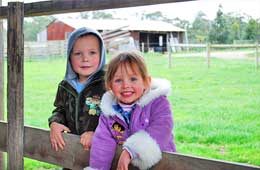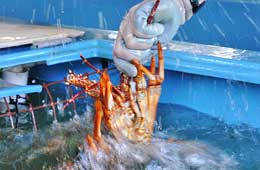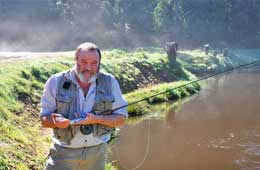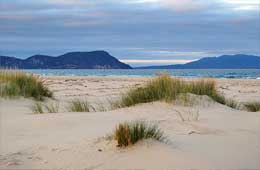Country to Coast Journal newspaper
FIONA and Mark Cripps operate Wings and Fins Seafood Restaurant at Tooradin Airfield where they serve the best crayfish in the world flown directly from Flinders Island.
The crayfish or southern rock lobster, are purchased from four different Flinders Island fishermen and transported well packed and alive by aircraft. When they arrive at Tooradin, they are put straight into huge live crayfish tanks at the back of the restaurant where they are monitored and cared for by Fiona, Mark and their staff.
They have two salt-water tanks that hold one tonne each but they don’t stock them to full capacity. “We only keep about 700 to 800 kilograms in each one,” Fiona said. “The tanks can hold them but when we have them a little bit scarce, we can look after them better.”
She said they check them as they are going in and if any of them are a bit abnormal or aren’t feeling too flash, they go into a sick bay, which is in the front part of one tank. When they are strong enough they go back in with the rest.
“If we leave them in the main tank, somehow the others know when they aren’t feeling well and eat them alive; they start with their legs and keep going. The only part they don’t eat is the top of their head where they are really spikey.
“We can tell when a crayfish isn’t well because normally they flick around and carry on when you pick them up and they are really hard to hold, but when they aren’t well you can virtually do anything with them. We just always have to be onto it and watch them.”
The water is checked in the morning and again at night before they leave. When they are closed for the day, they still come back to check on the crayfish and to make sure the tanks are right, the salt levels are right and the temperatures are fine.
The crayfish don’t stay in the tanks long enough to need feeding because they are sold so quickly. “We had one that stayed for a while,” she said. “He was Mark’s mate. We couldn’t sell him at the time so he stayed in the tank for about five months and we fed him small bits of flake or prawn, but he was cooked up not long ago when we didn’t have other crays.”
Occasionally they come across little black crayfish that have migrated to Flinders Island from New South Wales. “We don’t find many and we don’t sell them because they are rare, we just keep them as our little friends and pets,” she said. “We have three and the girls that work in the restaurant have named them all and they look after them.”
Crayfish shed their shells once a year when they moult. It’s a time when they are vulnerable because they are soft and it’s three to four weeks before they harden up again. If they lose a claw or a leg it will grow back the next time they moult. “We’ve had four or five shed their shells here and we have actually watched one pop out- it’s amazing,” she said. “The head to the tail breaks and then all of them including their head, legs and eyes just slip out. They are white with a slight purple tinge and as they get harder, they get darker in colour.
“When Pinchy, one of our pet crayfish moulted recently, he came out white. He has been with us since we opened which is nearly two years ago and since then he’s shed his shell twice. He’s very special to us.”
In the restaurant, there is another small tank mounted into the wall and Pinchy who is presently in sick bay while he moults, is normally there socialising with the customers. “I think if we ever cooked him, the girls would be devastated.”
The Flinders Island southern rock lobster can be 600 grams to five kilograms. “Some of the big ones we cook can be many years old and sometimes I feel guilty about that but they breed prolifically. From October 1 to the middle of November is their spawning season and during that time they are completely off limits.”
The crayfish at Tooradin are cooked on Wednesdays and again on Fridays. Mark takes them out of the tank and puts them into large plastic tubs and then piles in a large amount of ice, which puts them to sleep. When they are asleep, he pours in fresh water and drowns them. “We don’t cook them alive and listen to squawking and squealing,” Fiona said, “we couldn’t do that. The way they are killed and cooked at the restaurant is the most humane way.”
In a room in the back of the restaurant, they have a large gas cooker that they fill with salt water to cook them in. The smaller ones take about 20 minutes, the larger ones take about half an hour, and he tests them. As soon as he takes them out of the hot water, he puts them straight into freezing cold fresh water that is mainly ice to stop them cooking. The cooling pot is right beside the cooking pot and they go straight from one to the other. They stay there for about 15 to 20 minutes until they are cool and from there they go straight into a cool room.
Fiona said cooking them in salt water keeps the flavour and textures. “We have to be careful when we cook crayfish and the cook has his own thermometer.
“During summer, the restaurant gets very busy and we cook a lot more crays,” she said. “In the lead up to Christmas, the demand is continuous and we work extremely long hours. Instead of the traditional Christmas roast, people are now wanting seafood. Last year on Christmas Eve, we had people queuing up along the balcony at 7am waiting for us to open at 8am to get crayfish.”
Fiona has brought other seafood in from Tasmania including oysters from St Helens. “We try to get as much fresh seafood as we can,” she said. “Fresh salt and pepper squid is also popular. We have a delivery of fresh fish and other seafood every second day. The only thing we have frozen are our prawns which are bought in Queensland and snap frozen on the boat, but the way they are done you’d think they had just been plucked from the ocean. Anything that comes from interstate now has to be frozen unless you charter your own planes, but wherever the fresh seafood is we try to be there to collect it.”
In the restaurant Fiona also caters for non-seafood eaters, vegetarians and cooks gluten free food.
Wings and Fins restaurant has operated on the airfield for about 25 years. It was initially known as ‘The Mangroves’ until Gary Morrison took over and renamed it Wings and Fins. From the balcony of the restaurant, there are beautiful views across Westernport Bay and there’s always plenty of activity and entertainment on the airfield. There are planes leaving and arriving, skydivers and Tiger Moth flights. Some people fly in, eat at the restaurant and fly out again.
By Wendy Morriss
Copyright © 2012 Wendy Morriss: Freelance Journalist. All Rights Reserved.





